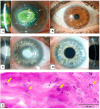Rethinking Keratoplasty for Patients with Acanthamoeba Keratitis: Early "Low Load Keratoplasty" in Contrast to Late Optical and Therapeutic Keratoplasty
- PMID: 39338475
- PMCID: PMC11434615
- DOI: 10.3390/microorganisms12091801
Rethinking Keratoplasty for Patients with Acanthamoeba Keratitis: Early "Low Load Keratoplasty" in Contrast to Late Optical and Therapeutic Keratoplasty
Abstract
Background: Early therapeutic penetrating keratoplasty (TKP) for Acanthamoeba keratitis (AK) is thought to have a worse visual prognosis than the delayed optical penetrating keratoplasty (OKP) after successful conservative treatment of AK. This has led to a tendency to prolong conservative therapy and delay penetrating keratoplasty in patients with AK. This retrospective series presents the results of patients with AK that underwent early penetrating keratoplasty after reducing the corneal amoeba load through intensive conservative therapy, so-called "low load keratoplasty" (LLKP).
Patients and methods: The medical records of our department were screened for patients with AK, confirmed by histological examination and/or PCR and/or in vivo confocal microscopy, which underwent ab LLKP and had a follow-up time of at least one year between 2009 and 2023. Demographic data, best corrected visual acuity (BCVA) and intraocular pressure at first and last visit, secondary glaucoma (SG), and recurrence and graft survival rates were assessed.
Results: 28 eyes of 28 patients were included. The average time from initiation of therapy to penetrating keratoplasty (PKP) was 68 ± 113 days. The mean follow-up time after LLKP was 53 ± 42 months. BCVA (logMAR) improved from 1.9 ± 1 pre-operatively to 0.5 ± 0.6 at last visit (p < 0.001). A total of 14% of patients were under medical therapy for SG at the last visit, and two of them underwent glaucoma surgery. The recurrence rate was 4%. The Kaplan-Meier graft survival rate of the first graft at four years was 70%. The second graft survival rate at four years was 87.5%.
Conclusion: LLKP appears to achieve a good visual prognosis with an earlier visual and psychological habilitation, as well as low recurrence and SG rates. These results should encourage us to reconsider the optimal timing of PKP in therapy-resistant AK.
Keywords: acanthamoeba keratitis; graft survival rate; low load keratoplasty; optic keratoplasty; therapeutic keratoplasty.
Conflict of interest statement
The authors declare no conflicts of interest. All authors attest that they meet the current ICMJE criteria for authorship.
Figures




References
LinkOut - more resources
Full Text Sources

